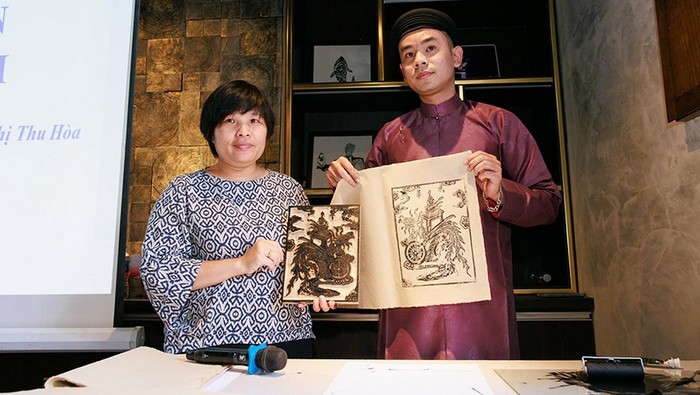Q: With five books published in just a few years, you havesurprised researchers and the public because there are not many people, even professional researchers, who have such a large number of works.
A: I myself am surprised when I look back on my journey. I have a passion for ceramics and pottery. During a trips to buy ceramics, I was introduced to folk paintings and realised that it was a very large world. For example, in the North, people only talk about Dong Ho, Kim Hoang and Hang Trong paintings. However, even the research on these kinds of folk paintings is incomplete. Coming to the central, south central and southern regions, I learnt about many other paintings that have not been popular, especially cloth wrapping paintings and glass mirror paintings.
Famous paintings such as Dong Ho and Hang Trong are all struggling to survive and many other types are in danger of being lost. The ten-year process of collecting and researching folk paintings has been a rush against time for me because the artisans are getting older. I do not understand why folk paintings are of little interest to researchers. This makes it difficult for me because there are few documents for reference and comparison.
Q: You said there are many folk paintings are in danger of being lost while many artisans no longer work. How did you exploit the documents on the techniques of making folk paintings to put these knowledges in your books?
A: From my initial passion, I became a painter, researcher andrestorer of Kim Hoang paintings before I began my deeper research into folk paintings in general.
There were artisans who no longer created paintings. I ordered them to paint so I could exploit their knowledge while directly observing their process of painting. This journey was very tiring. There are the paintings that that require a lot of effort so the artisans were afraid to work on them. I had to enthusiastically convince them to restore them. There are spiritual paintings that will be burned or released on the rivers. If you want to understand the paintings, you must learn about the cultural spiritual activities. This is also not easily accessible.
Q: Folk paintings are often known as decorative art, but she has just referred to the type of paintings used as votives. Do those paintings have artistic value?
A: Many types, including Dong Ho and Kim Hoang, have such paintings. Particularly, Sinh Village in Hue specialises in these spiritual paintings. Humans always have the need to "communicate" with gods and spirits of the deceased through offerings. In a civilised society, people use substitutes for the real thing. The most popular of such items are woodblock prints.
The spiritual paintings still have high artistic value and contain many cultural stories. The spiritual paintings of Sinh Village are a typical example, reflecting the spiritual world of locals in Hue City - a place witnessing the cultural interference between Vietnamese and Cham people and the long-standing war in the past. The South Central Coastal region worships sea gods, so the locals createdmany spiritual paintings related to sea. Many paintings can be applied to modern art products, such as ismages of animals, people or boats, if they are fully studied. I believe that traditional patterns, textures and techniques in spiritual paintings have very high applicability.
With thousands of patterns, the spiritual paintings’ potential for application in the cultural industry, especially in product packaging design, exploitation of materials for application in fine arts and decoration is very huge.
Q: How do you evaluate the exploitation of these resources? And do you intend to set foot in this field?
A: Many young people have succeeded in exploiting the elements of folk paintings into applied art and graphic decoration. There are artists creating many paintings based on the materials of folk paintings and selling them at high prices, not only in Vietnam but also abroad. That is the Vietnamese cultural identity in the cultural industry. However, compared with the existing potential, the exploitation of folk paintings is at the beginning stage. My colleagues and I have also developed a range of new models of Kim Hoang paintings on the basis of traditional materials. However, this is not my main goal. I want to preserve the painting techniques and bring the unique values of folk paintings to the community. I am about to release my second book on Kim Hoang paintings.
Q: Are you planning to do a "collection" of research on folk paintings?
A: I am afraid I cannot do it. However, sometimes I still think of that as motivation. The fact that few people study folk paintings is a disadvantage in research, but as a result, I discovered "new" things that are not in books during my trips. And that fact also shows that the space for studying folk paintings is still very large.
Thank you very much!
















